What do you think when you hear ringing bells? There are bells that ring every hour to mark the passing of time. Then there are bells that are rung to celebrate significant events and celebrations.
Since the introduction of cast iron bells over a thousand years ago, they have been an important part of our culture. But did you know that old cast iron bells can be valuable?
In this article, you will find information about the history of cast iron bells, the types of bells and how to identify a cast iron bell. We have also included information on the value of old cast iron bells and how to look after your antique bell.
Table of Contents
History of Cast Iron bells
Bells are an important part of the western countries’ heritage. However, bell-founding in Europe only began in the fourth or fifth century compared to around 2000 BC in Asia. When bells were introduced in Europe, they became popular in clock towers, churches, and homes to signify time and important events.
Since the early days of bells in Europe, churches have used them in religious ceremonies. Bells were put in the clock towers in villages, towns, and institutions to denote time. At home, you would often find a cast iron dinner bell used to call household members for dinner.
Some of the earliest bells found in Europe have been discovered in the Nordic countries. They were usually positioned on top of barns and they would ring them to tell the farmers to come home at the end of the day.
Some of the earliest bells were made of pottery, then copper and bronze became more popular. The bronze bells, which included 23% tin, had the best tones. They were cast, mouth down, and molten bronze or molten copper would be poured into a two-part mold.
Iron replaced bronze as the main material for bells around 1000 AD. Using iron made it possible to build bigger bells with unique shapes and designs using a new Chinese method where molten iron was poured into molds to create the desired shape. The oldest cast iron bell has been dated back to 1079.
Styles Of Old Cast Iron Bells
Cast iron bells come in many forms and sizes. They have been used on farms, on boats and trains, school houses, town halls and churches and to call firemen to extinguish fires. Over the centuries bells have been used as part of religious festivals, as warning signs, and at homes.
Bells used in public buildings, such as churches were larger since their purpose was to summon people from further away. The bigger the bell, the louder the sound. The household bells were the smallest. Here are examples of different types of cast iron bells.
Farm bells
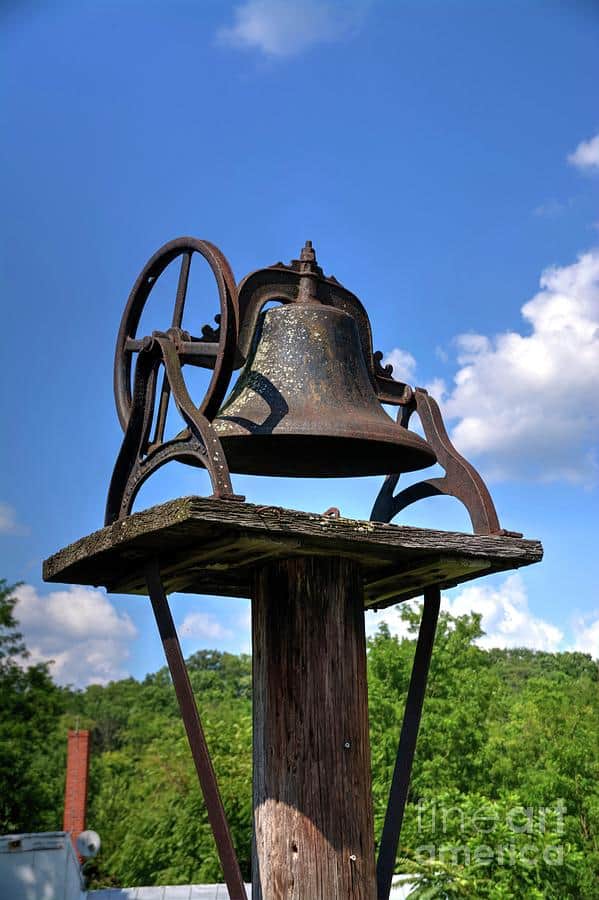
Bells have been an integral part of farming life in America and the Nordic countries. They were used to summon the workers home from the sprawling lands and fields. The toll of these farms’ bells would signal lunch times and when it was time to down tools at the end of the day.
The best way to distinguish a farm bell from other bells is by its size. Antique farm bells were typically 10-20 inches in diameter and weighed 25-100 lbs. They were smaller than other utilitarian bells as they didn’t need to ring as loud as bells used in towns and cities. Smaller bells were also cheaper and easier to transport.
School House and Factory Bells
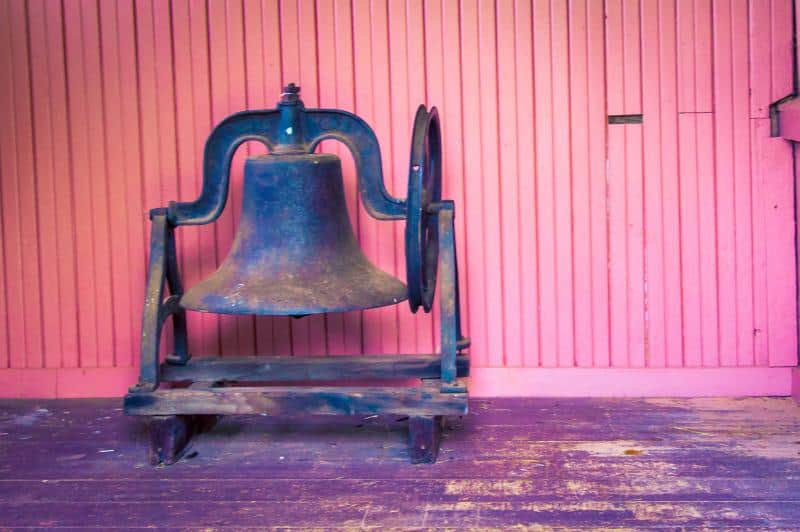
School and factory bells are heavier than farm bells weighing between 165 and 1,275 lbs. They were also bigger in diameter, usually measuring 20 to 28 inches across the mouth of the bell. Often the bells were sold with a frame, wheel and wood sills and then placed in the upper rafters of a belfry of an attic.
The bells used at schools and factories were meant to have a higher sound than church bells so they would not confuse the hearer. They were smaller than church bells so had a higher, sharper tone compared to the deeper sound of larger church bells.
Church Bells
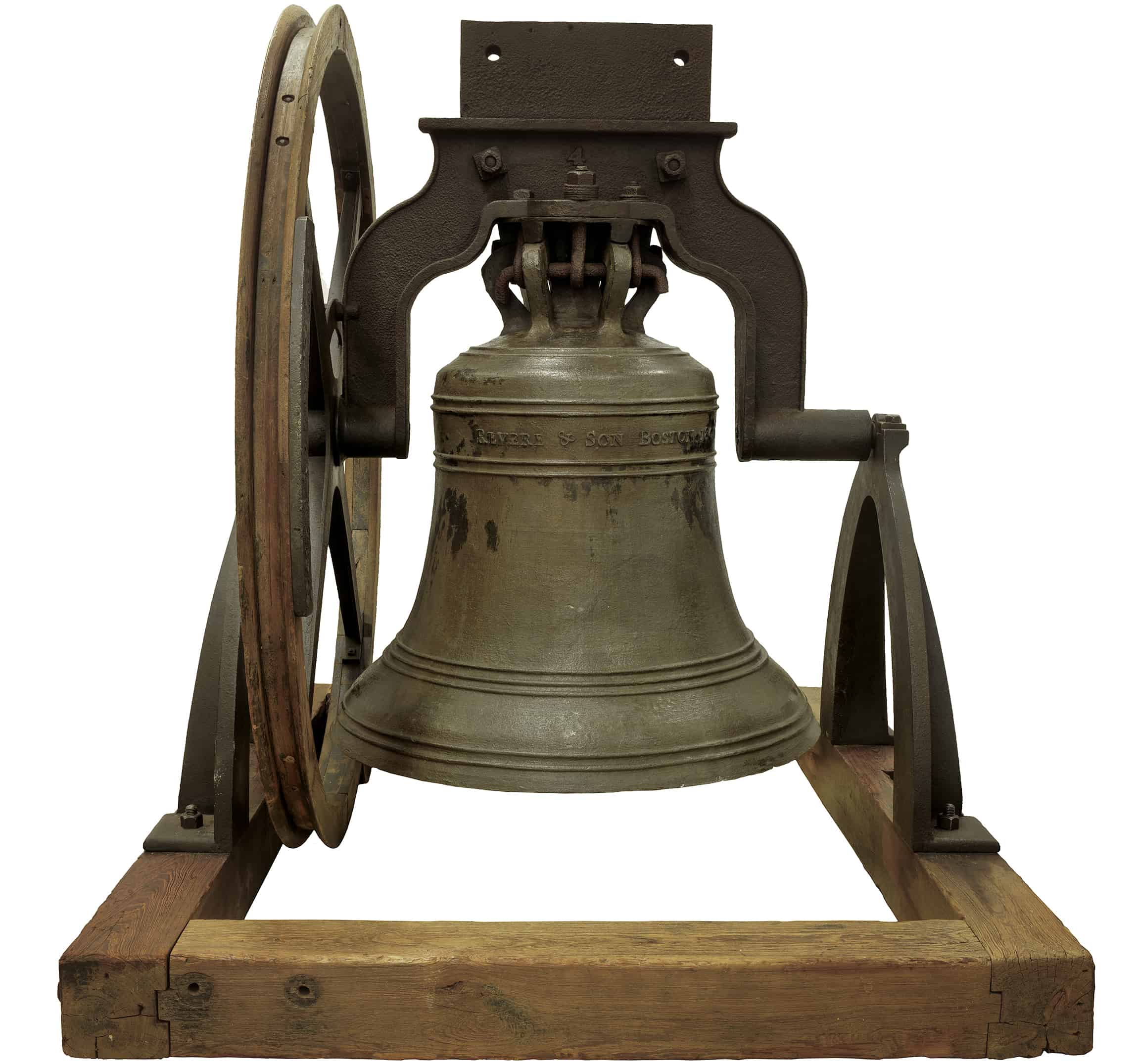
Bells have been used in Christian churches since around 400 AD. They are larger than school or factory bells so their sound carries further. The sizes in diameter generally range from 27 to 62 inches and the weight from 400 to 5,000 lbs.
The biggest bells were used in bigger churches and in cathedrals while smaller bells were better suited for smaller churches and chapels. In the early days of church bells, they were cast in different sizes to produce different sounds. Later, with the advance of bell tuning, bells were carefully shaped and cast in different thicknesses along their length to create different sounds.
Rail and ship bells
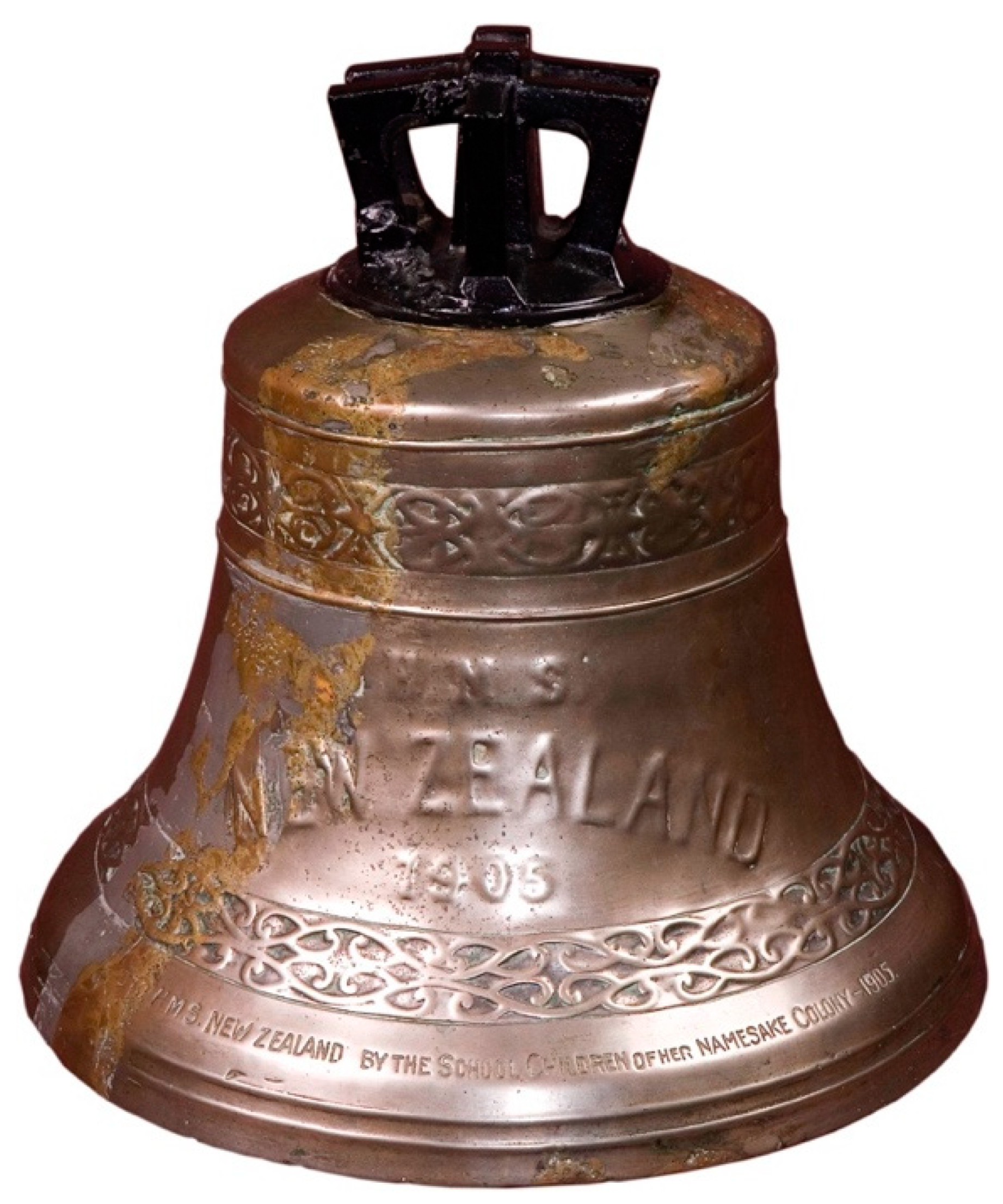
Bells have been used on trains to alert people and animals of the approaching train. Most train bells were 11-17 inches at the mouth and they often had identifying markers to connect them with a specific train.
On riverboats, warships and passenger cruise boats, bells were hung from a mast or mounted into a position on the upper deck. They were used to mark time and to announce an important person boarding the vessel. Bells on ships were also important for safety when they were used to indicate the ship’s position in heavy fog.
How to identify an old cast iron bell?
Some bells that look old, but are not antique and therefore not valuable, can sometimes be easily confused with real antique cast iron bells. Therefore, it is important to know how to identify authentic antique cast iron bells.
Check if there is a casting line on the bell
If it has one, then it is not an authentic old cast iron bell. Original cast iron bells do not have casting lines since they were made in one piece.
Scrutinize the edges of the bell
If the bell is authentically old, it will have edges that have softened, become irregular over time, or show signs of heavy wear. New bells are likely to have sharper edges which might have been made to look irregular in an attempt to make the bell look older.
Check out the body of the bell
Even if it has been restored, it will still bear marks of usage. It will look older and weathered, including the edge, as mentioned above, being worn. Also, check for reeds of decorative ridges on the body. Early bell foundries used them to identify their products.
Look for markings on the bell
The markings are usually on the yoke. These markings on antique bells will give you information on the manufacturer or the retailer of the bell.
If you are looking to buy a bell, check it for cracks or repairs, especially if you want to ring the bell rather than just purchase it for decorative purposes. The bell will not ring true and clear if it has been damaged.
How much are old cast iron bells worth?
What makes cast iron bells valuable is the fact that they cannot be remade. They are antique and unique. Also, although today’s technology has made it possible to mass-produce bells, a mass-produced bell cannot match the quality of old cast iron bells.
How much an antique cast iron bell is worth depends on its size and weight. Here are some examples of what old bells can be worth.
Small bells, such as antique farm bells or dinner bells, are not extremely valuable because of their size. Recently, household bells have sold on eBay from $26 to $59.
Old antique cast iron school house bells are bigger, the diameter is usually between 20 and 30 inches, and therefore more valuable. Old school bell worth has ranged between $225 and $500 on eBay.
Old church bells are the largest and heaviest cast iron bells and can weigh over 2000 lbs. Their size makes them more valuable. In recent auctions, the prices range for bells in perfect condition has been from $347 to $950.
Bells from certain manufacturers, such as McShane Bell Foundry, are popular with collectors of bells and therefore worth more. For example, a half-ton model will cost you over $13,000. Other bell makers to look out for include O.S. Bell and Company and C.S. Bell and Hillsboro.
Looking after your cast iron bell
Old cast iron bells are also a great investment, as their value is likely to increase over time. Just make sure to keep your bell away from harsh elements to protect its sound and condition. You might want to speak to a restoration expert about cast iron bell restoration and how to maintain the patina of your bell.
You can also improve the appearance of your bell yourself by following these steps.
- Use a wire brush to remove loose paint or rust.
- Wipe it clean with a microfiber cloth or soft rags and spray with a thin coat of Rustoleum primer to seal the surface.
- Give the bell a brush coat of good-grade machinery enamel.
If you are looking for an authentic touch of history for your home, then old cast iron bells are a great choice. You can search for them online, but other good places include flea markets, garage sales and antique stores.
Should you have questions about old cast iron bells, let us know them in the comments section.
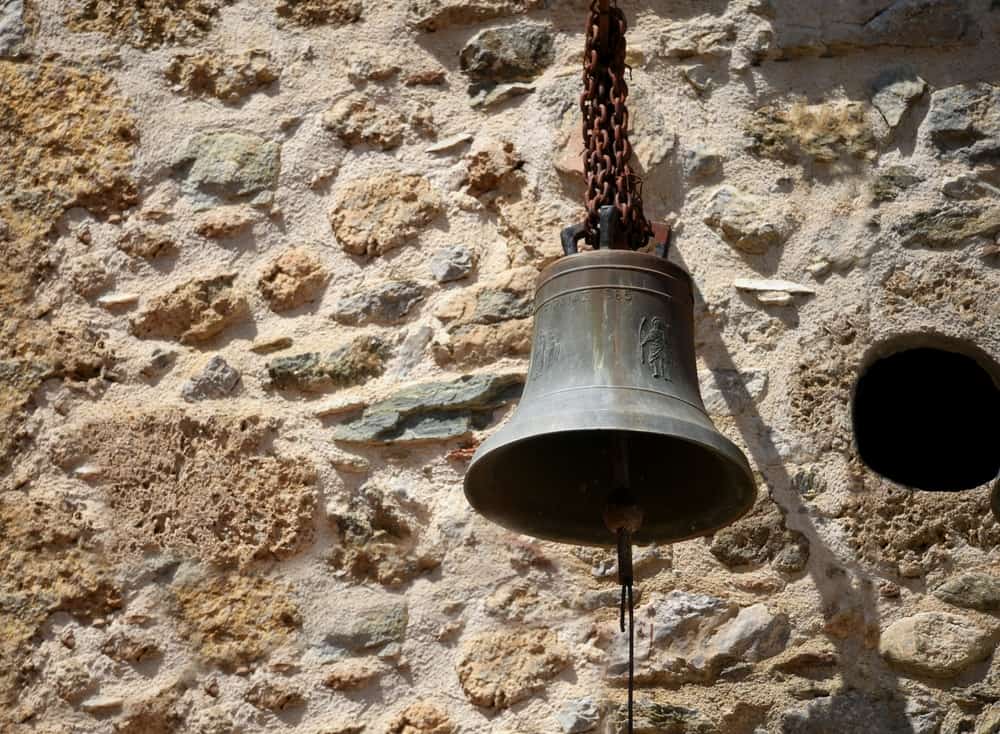
Have an old cast iron small bell with Spanish words that was found in the Philippines during the Spanish American War from a mission I think and brought back to US. By a U. S. soldier in 1899. Think is was very old then too. Perhaps 1600/1700’s.
Any thoughts or value. Would like to keep it in the family….
Thanks,
Robert
I have a locomotive steam Engine Bell cast iron
markings “General Electric Pat.#25
Novalux Schener NY USA ??1227328 H ??
??these # are not readable ,
If you have any information on age and value,I would appreciate,
thank you
MY CLUB HAS THE CAST IRON BELL OF A LOCAL COLLEGE THAT I 126 YEARS OLD. WHAT WOULD THE VALUE BE?